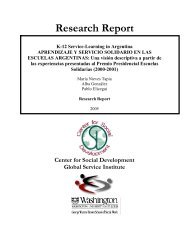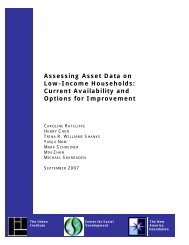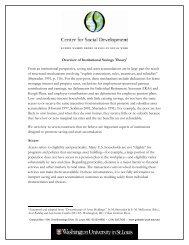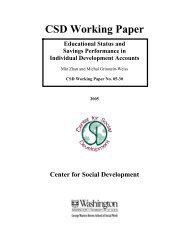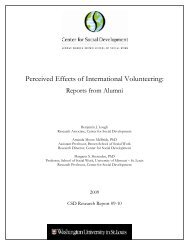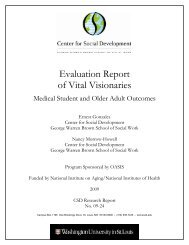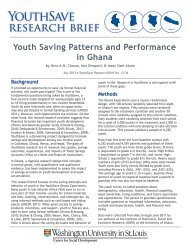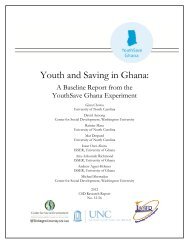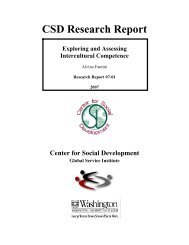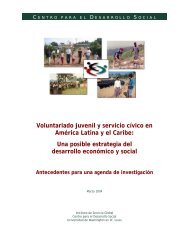Rediscovering social investment in developmental welfare state ...
Rediscovering social investment in developmental welfare state ...
Rediscovering social investment in developmental welfare state ...
Create successful ePaper yourself
Turn your PDF publications into a flip-book with our unique Google optimized e-Paper software.
R E D I S C O V E R I N G S O C I A L I N V E S T M E N T I N D E V E L O P M E N T A L W E L F A R E S T A T E P O L I C I E S :<br />
B A C K T O T H E F U T U R E<br />
It supports a view that one cannot dichotomize <strong>social</strong> policies as either <strong><strong>in</strong>vestment</strong>s or costs <strong>in</strong> and<br />
of themselves. Policies may simultaneously have <strong><strong>in</strong>vestment</strong> and consumption aspects (Esp<strong>in</strong>g-<br />
Andersen, 2002, 2003) whose effects may vary <strong>in</strong> comb<strong>in</strong>ation (i.e., cumulatively or<br />
<strong>in</strong>terdependently) with other policies. Developmentalism suggests a need to take <strong>in</strong>to account the<br />
potentially synergistic nature of policies and recognize that policies must be considered <strong>in</strong> terms of<br />
the way they <strong>in</strong>teract, not discretely. Economic performance and efficiency do not come exclusively<br />
from cutt<strong>in</strong>g costs but rather expand<strong>in</strong>g <strong><strong>in</strong>vestment</strong>s (Andersson, 2005). For <strong>in</strong>stance, if <strong>social</strong> risks<br />
entail associated costs and <strong>social</strong> <strong><strong>in</strong>vestment</strong>s are synergistic, perhaps this argues aga<strong>in</strong>st selective<br />
assistance to those <strong>in</strong> need and <strong>in</strong> favor of prevent<strong>in</strong>g need. Further, rather than argu<strong>in</strong>g aga<strong>in</strong>st<br />
entitlements on the basis that they simply reflect passive consumption, it may be that this short-term<br />
consumption also reflects a long-term <strong><strong>in</strong>vestment</strong>. A policy-relevant <strong>in</strong>terpretation of <strong>welfare</strong><br />
<strong>developmental</strong>ism suggests that the economic and <strong>social</strong> are often fundamentally related <strong>in</strong> the same<br />
policy, expenditures, and benefits of various sorts are not <strong>in</strong>herently at odds with <strong>social</strong> <strong><strong>in</strong>vestment</strong>,<br />
and <strong>developmental</strong>ist policy is <strong>in</strong>teractive and synergistic. What does this view of <strong>welfare</strong><br />
<strong>developmental</strong>ism suggest about the nature and beneficiaries of <strong>developmental</strong>ist policies?<br />
Midgley (1999) offers examples of what productive <strong>social</strong> development programs should focus on,<br />
<strong>in</strong>clud<strong>in</strong>g cost effectiveness, human capital <strong><strong>in</strong>vestment</strong>s, <strong>social</strong> capital formation, <strong>in</strong>dividual and<br />
community assets, economic participation through productive employment and self-employment,<br />
removal of barriers to economic participation, and the creation of a <strong>social</strong> climate conducive to<br />
development (e.g., Midgley, 2001; Midgley, 2003a; Midgley & Tang, 2001). Related work is<br />
suggestive of when and for whom <strong>social</strong> policies should be focused. It may be especially important to<br />
target benefits to key groups of people at critical periods of time. For example, Esp<strong>in</strong>g-Andersen<br />
(2002, 2005) identifies three vulnerable groups: (1) children and their families, (2) those <strong>in</strong> the midst<br />
of work life, who may experience tensions between family life and paid work, and (3) the elderly.<br />
Relatedly, new and stochastic risks complicate traditional actuarial <strong>in</strong>surance (Esp<strong>in</strong>g-Andersen,<br />
2000b; Hacker, 2008; Newman, 2008; Taylor-Gooby, 2004; Vandecasteele, 2011). 33 F<strong>in</strong>ally, with<br />
respect to how <strong><strong>in</strong>vestment</strong>s should be made, Gough (2000, 2001b) suggests that there are tradeoffs<br />
and constra<strong>in</strong>ts <strong>in</strong>volved <strong>in</strong> <strong>welfare</strong> <strong>state</strong> effort and effects and contends, for example, that programs<br />
need to be directed at improv<strong>in</strong>g the supply of capital and/or labor rather than merely provid<strong>in</strong>g<br />
resources to some <strong>in</strong> need.<br />
Based on the revised view of <strong>social</strong> development adapted from Midgley, the central premise of<br />
Myrdal‘s unified socioeconomic plann<strong>in</strong>g approach, and <strong>in</strong>sights from the <strong>welfare</strong> statist/<strong>social</strong><br />
adm<strong>in</strong>istration approach, I propose several policy-relevant <strong>developmental</strong>ist pr<strong>in</strong>ciples that are<br />
suggestive of the type of <strong>social</strong> policies that are likely to yield both productive and protective<br />
outcomes. While these pr<strong>in</strong>ciples rema<strong>in</strong> somewhat vague at this stage of theoretical development,<br />
their implications become more precise when applied to th<strong>in</strong>k<strong>in</strong>g about major <strong>social</strong> policy<br />
categories <strong>in</strong> developed <strong>welfare</strong> <strong>state</strong>s. These pr<strong>in</strong>ciples <strong>in</strong>clude the follow<strong>in</strong>g:<br />
33 In particular, <strong>in</strong>tergenerational risks (i.e., risks transmitted from parents to children) are difficult to deal with. Esp<strong>in</strong>g-<br />
Andersen (2000b, p. 4) writes: ―In conventional <strong>social</strong> policy thought, unpredictable and stochastic risks have been<br />
relegated to (often ad hoc) <strong>social</strong> assistance programmes. The sharp rise <strong>in</strong> <strong>social</strong> assistance caseloads almost everywhere<br />
<strong>in</strong> developed countries mirrors the decl<strong>in</strong><strong>in</strong>g efficacy of the conventional <strong>in</strong>surance approach.‖ He adds that the risk<br />
view tends to <strong>in</strong>dividualize <strong>welfare</strong> issues, as opposed to recogniz<strong>in</strong>g <strong>welfare</strong> <strong>in</strong>terplays. The Cross-National Research on<br />
the Intergenerational Transmission of Advantage (CRITA) project is one attempt be<strong>in</strong>g led by Tim Smeed<strong>in</strong>g to explore<br />
the issue.<br />
C E N T E R F O R S O C I A L D E V E L O P M E N T<br />
W A S H I N G T O N U N I V E R S I T Y I N S T . L O U I S<br />
23



